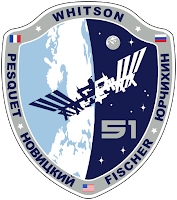ISS - Expedition 51 Mission patch.
April 21, 2017
(Highlights: Week of April 10, 2017) - Three crew members returned to Earth as NASA astronaut Peggy Whitson prepared for another round of a groundbreaking study on the International Space Station.
Whitson completed setup and updated the software for the Biomolecule Sequencer, a device that allows crew members to sequence DNA for various experiments in space. DNA sequencing is typically difficult and time-consuming and requires bulky and expensive equipment. This investigation tests a miniature sequencer in space to diagnose infectious diseases, identify microbes, and better understand the genetic changes experienced by astronauts while in space.
Image above: NASA astronaut Shane Kimbrough is flanked by his fellow space station crew mates – Russian cosmonauts Andrey Borisenko, left, and Sergey Ryzhikov– shortly before closing the hatch on their Soyuz capsule and returning to Earth from the space station on April 10. Image Credit: NASA.
Thanks to the sequencer samples with a short life-span would not need to be frozen and returned to a lab on Earth for analysis. Those samples can be examined on the station immediately after being collected, transmitting the data back to the ground, saving valuable research time. The real-time collection of genomic data will greatly improve scientific research in orbit. The small size of the Biomolecule Sequencer, approximately the size of a deck of playing cards, could also help doctors save lives in remote countries with minimal resources.
Whitson also installed a new hard drive into the locker for the re-flight of the Device for the study of Critical Liquids and Crystallization (DECLIC HTI-R) investigation. DECLIC HTI-R is an experiment that studies water near its critical point -- the point beyond which water loses its distinction between liquid and vapor and begins to behave as a dense gas. Salt tends to precipitate out from water at temperatures and pressures beyond this critical point. Understanding this behavior will assist designers in building extended-life, low-maintenance water oxidation reactors resistant to salt deposits and corrosion, providing a more environmentally friendly waste management system and reducing operating costs of power plants on Earth that use water for its working or coolant fluid. DECLIC is an investigation developed by the French Space Agency in Toulouse.
Image above: European Space Agency astronaut Thomas Pesquet performs maintenance on a science investigation on the International Space Station. Image Credit: NASA.
Whitson and ESA (European Space Agency) astronaut Thomas Pesquet completed a session for the Effects of Long-Duration Microgravity on Fine Motor Skills (Fine Motor Skills) investigation. Fine motor skills are crucial for successfully interacting with touch-based technologies, repairing sensitive equipment and a variety of other tasks. For NASA's Fine Motor Skills investigation, crew members perform a series of interactive tasks on a touchscreen tablet. The investigation is the first fine motor skills study to measure long-term microgravity exposure, different phases of microgravity adaptation, and sensorimotor recovery after returning to Earth gravity. The simple tasks developed for this investigation may have wide-reaching benefits for elderly patients, people with motor disorders or patients with brain injuries on Earth undergoing rehabilitation for conditions that impair fine motor control.
ScienceCasts: Using a Tablet Computer in Space
Video above: The Fine Motor Skills experiment on the station is looking at how long-duration microgravity effects fine motor task performance. Image Credit: NASA.
Other human research investigations conducted this week include Biochemical Profile, Lighting Effects and Dose Tracker.
Progress was made on other investigations, outreach activities, and facilities this week, including Rodent Research 4, Veg-03, NREP Inserts, ISS Ham Radio, EXPRESS Rack, FIR, Microgravity Science Glovebox, MSL Batch 2b, JAXA ELF, Manufacturing Device, and Group Combustion.
Related links:
Biomolecule Sequencer: https://www.nasa.gov/mission_pages/station/research/experiments/2181.html
Tests a miniature sequencer in space: http://www.nasa.gov/mission_pages/station/research/news/dna_sequencing
Device for the study of Critical Liquids and Crystallization (DECLIC HTI-R): https://www.nasa.gov/mission_pages/station/research/experiments/1030.html
Fine Motor Skills: http://www.nasa.gov/mission_pages/station/research/experiments/1767.html
Biochemical Profile: https://www.nasa.gov/mission_pages/station/research/experiments/1008.html
Lighting Effects: https://www.nasa.gov/mission_pages/station/research/experiments/2279.html
Dose Tracker: http://www.nasa.gov/mission_pages/station/research/experiments/1933.html
Rodent Research 4: https://www.nasa.gov/mission_pages/station/research/experiments/2025.html
Veg-03: http://www.nasa.gov/mission_pages/station/research/experiments/1294.html
ISS Ham Radio: http://www.nasa.gov/mission_pages/station/research/experiments/346.html
Microgravity Science Glovebox: https://www.nasa.gov/mission_pages/station/research/experiments/350.html
MSL Batch 2b: https://www.nasa.gov/mission_pages/station/research/experiments/1978.html
JAXA ELF: https://www.nasa.gov/mission_pages/station/research/experiments/1999.html
Group Combustion: https://www.nasa.gov/mission_pages/station/research/experiments/1077.html
Space Station Research and Technology: https://www.nasa.gov/mission_pages/station/research/index.html
International Space Station (ISS): https://www.nasa.gov/mission_pages/station/main/index.html
Images (mentioned), Video (mentioned), Text, Credits: NASA/Kristine Rainey/Jorge Sotomayor, Lead Increment Scientist Expeditions 51 & 52.
Greetings, Orbiter.ch



